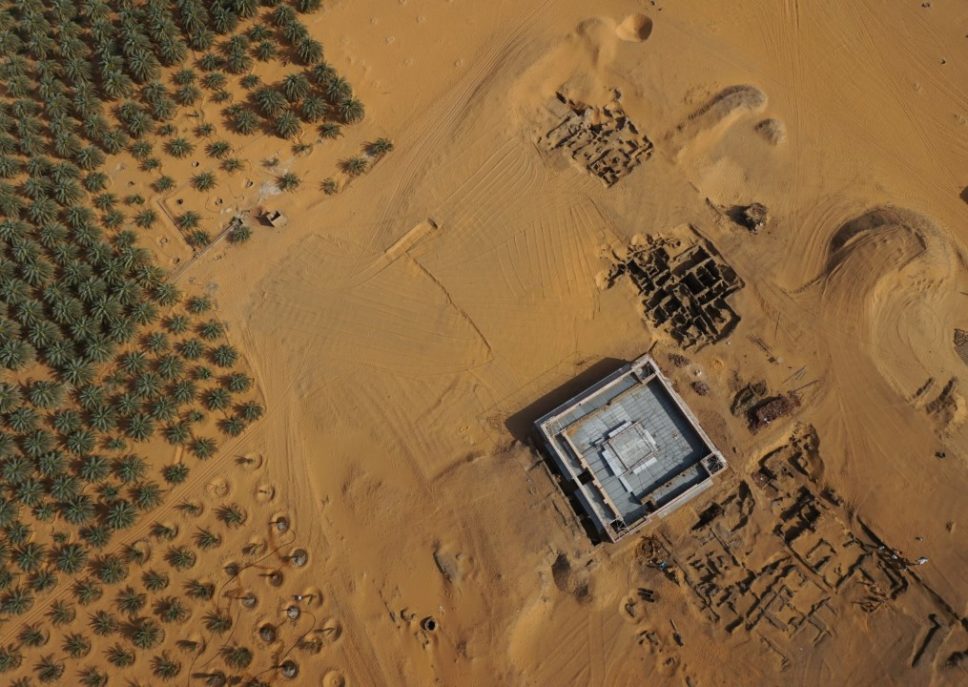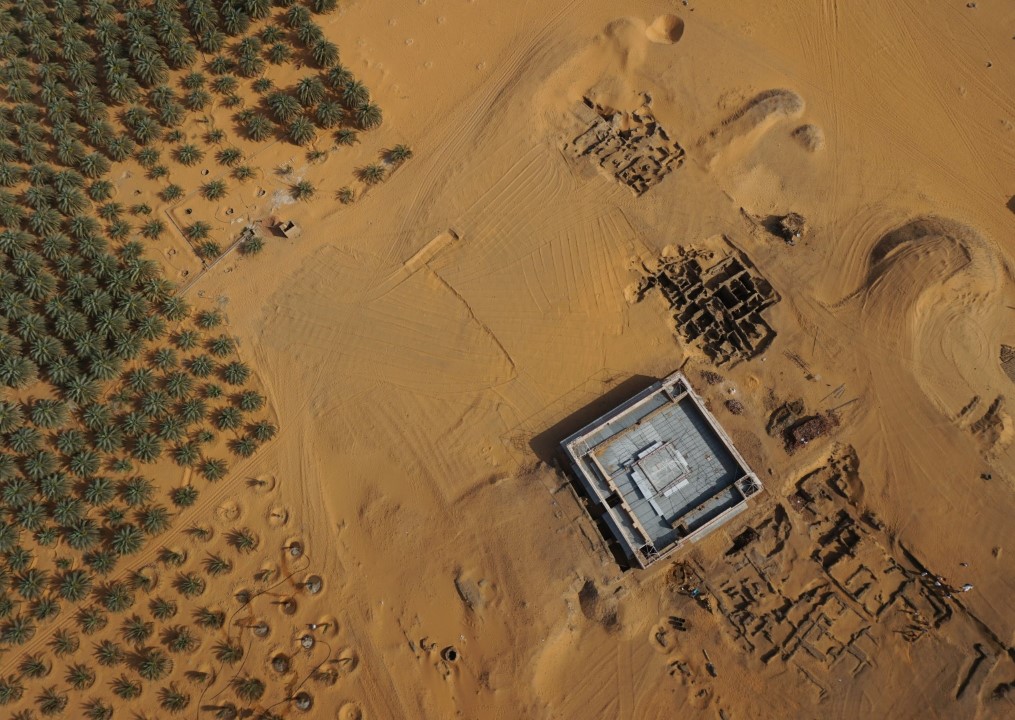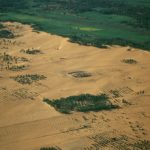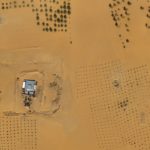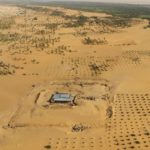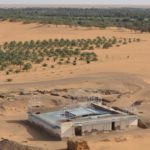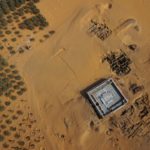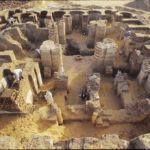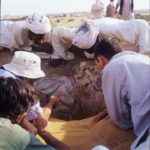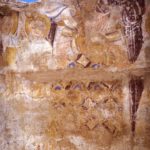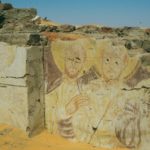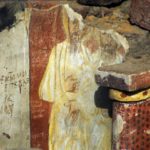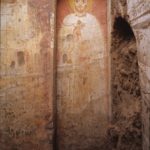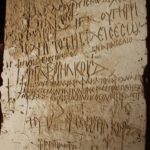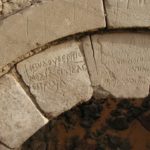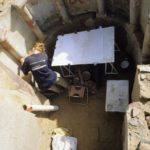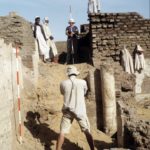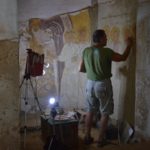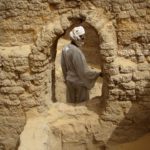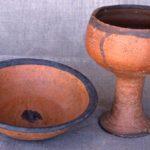Banganarti
-
Project name:
Polish Archaeological Expedition to Banganarti and Selib
Facebook:
-
Type of site:
Fortified settlement with a church
Location:
Sudan
Ancient Nubia
Kingdom of MakuriaDating:
– Medieval period (6th/7th–16th century AD)
Most interesting finds:
– Raphaelion church – pilgrim center dedicated to the Archangel Raphael
– Parts of fortifications with an enclosure wall built entirely of dried bricks
– Wall paintings inside the Raphaelion depicting saints, Archangels, Nubian rulers and dignitaries
– Approximately 1,000 inscriptions left by pilgrims on the walls of the Raphaelion
– Stone funerary stelae with Greek epitaphs
– An assemblage of completely preserved ceramic liturgical vessels
History of research:
Investigated by the PCMA mission in:
1998–2020
(the research was continued without the participation of PCMA UW)
Type of research:
– Excavations; conservation and reconstruction work
Director:
Bogdan Żurawski, Institute of Mediterranean and Oriental Cultures, Polish Academy of Sciences
Co-operating institutions:
– Polish Centre of Mediterranean Archaeology, University of Warsaw
– Institute of Mediterranean and Oriental Cultures, Polish Academy of Sciences
– Institute of Archaeology, University of Rzeszów (since 2016)
– National Corporation for Antiquities and Museums
Additional information:
The project has received funding for 2014–2019 from The Qatar-Sudan Archaeological Project. Additionally, a research project entitled “Archangels and locust. Daily life in Banganarti, a pilgrim center on the Middle Nile, the 6th through the 16th century” is being carried out under the OPUS funding scheme of the Polish National Science Centre (no. 2016/21/B/HS3/03724), to be realized in 2017–2020.
The site was first recorded archaeologically in 1984 during a survey of the Nile valley conducted between el-Khandak and Fakrinkotti by an expedition from the Royal Ontario Museum. It was designated as ROM 53. In 1998, it was prospected once again (and called SDRS Bng1), this time as part of the Southern Dongola Reach Survey organized by a Polish archaeological mission directed by Bogdan Żurawski. Aerial photographs of the site were also taken at that time. These activities led to the undertaking of regular archaeological work which has been carried out in Banganarti by the Polish archaeological mission since 2001.
Additional research of the Polish Archaeological Expedition to Banganarti and Selib
Apart from regular excavations, the Polish Archaeological Expedition to Banganarti and Selib participated in several salvage campaigns connected to the building of dams on the Nile which resulted in the flooding of vast areas of the Nile valley. Between 2005 and 2010, salvage projects were conducted in the 4th Cataract region in the framework of the Meroe Dam Archaeological Salvage Project. In 2013, as a result of surveys carried out in the area of the 3rd and 4th Cataracts, defensive structures (fortresses Shofein and Marakul) were studied. The documentation of fortresses in the area of the 3rd Cataract was continued in 2016 (Fagirinfenti and Kisenfarki), and in the following years, ethnoarchaeological research was conducted in the vicinity of the Jawgul village.
Description of the site and research:
Banganarti (a toponym of Old Nubian origin, literally “the locust island” lies on the right bank of the Nile, approximately 10 km downriver from Old Dongola, the ancient capital of the Christian kingdom of Makuria /1/. The archaeological site, with a high kom in the center, also called by the locals kom es-Sinad or Jebel en-Nasara, is located in the strip of land dividing the cultivated fields from the buildings of the modern village /2, 3/. The remains of a church surrounded by a dense and fortified settlement were discovered here.
In the first seasons, the work concentrated on the central, highest part of the kom and the remains of a sacral building with a layout atypical of Nubian churches. The square building (25 m long and wide) housed 18 chapels/rooms located symmetrically around four central pillars which had probably supported a dome. Staircases were situated in the western corners, while the seven chapels on the eastern side were enclosed by apses, with additional two narrow rooms behind them. Porticoes ran along the north, south and west walls. The church was erected on top of an older structure, the walls of which had been leveled to the height of approximately 2 m above floor level and used as foundations for the later building.
The layout and interiors of both edifices, designated as Upper and Lower Church, were altered several times. The oldest church in Banganarti was erected probably at the end of the 6th or the beginning of the 7th century and was rebuilt at least three times, going from a characteristically Nubian tripartite building to one with a cross-like layout. The latter was typical of commemorative buildings; in the Lower Church, burials discovered on two sides of the room at the eastern end of the building may have served this function.
The Upper Church was built in the second half of the 11th century. It functioned as a place of Christian worship presumably until the 15th century. The name Raphaelion derives from the patron saint of this church (and probably the older one as well), the Archangel Raphael /4, 5, 6/. For several centuries, it was a pilgrim center, as attested by approximately 1,000 inscriptions left on its walls by numerous visitors /12, 13/, mostly in Greek and Old Nubian or a mix of these two languages.
Wall paintings which decorated the walls of the Raphaelion /7, 8, 9, 10, 11/ are among the most important discoveries made in Banganarti. The eastern apses feature large figurative scenes depicting the Archangel surrounded by the Apostles and protecting a Nubian king. In the other rooms, there are Biblical and apocryphal scenes, as well as depictions of saints, including Cosmas and Damian, secular figures, Nubian rulers and high dignitaries.
Apart from the excavations in the central part of the kom, the enclosure wall was also studied /17/. It delimited the area of the settlement which resembled a rectangle and measured 120 m by 90 m. Some sections of the wall and circular or semi-circular towers inside it were built of dried bricks and were preserved up to 3.5 m in height.
In recent years, excavations were carried out between the church and the enclosure wall. Located there were both typical houses and public buildings, as well as areas serving the needs of pilgrims. Numerous objects were found, the majority being ceramic vessels dating from the end of the 6th century almost through the 16th century. Stone tools, small glass and metal objects complete the picture of everyday life in medieval Banganarti /18/.
Results of the research:
Season by season – PCMA Newsletter:
- 2016 season
- 2015 season
- 2014 season
- 2013 season
- 2012 season
- 2011 season
- 2010 season
- 2009 season
- 2008 season
- 2007 season
- 2006 season
Osypińska, M., & Żurawski, B. (2020). Pork for pilgrims: Livestock breeding and meat consumption at medieval Banganarti, Nubia. Antiquity, 94(373), 164–178. doi:10.15184/aqy.2019.235
Drzewiecki, M. (2017). The medieval fortifications at Banganarti after the 2016 season. Polish Archaeology in the Mediterranean, 26/1, 301–309.
Dzik, M. (2017). The North-East living quarter of the medieval pilgrim centre in Banganarti. Polish Archaeology in the Mediterranean, 26/1, 289–300.
Żurawski, B. (2017). Fieldwork in 2015/2016 in the Southern Dongola Reach and the Third Cataract Region. Polish Archaeology in the Mediterranean, 26/1, 269–288.
Żurawski, B. (2016). Banganarti and Selib in the 2013/2014 and 2014/2015 seasons. Polish Archaeology in the Mediterranean, 25, 349–402.
Żurawski, B. (2016). Banganarti Nativity: Enkolpion with scene of the Birth of Jesus from House BA/2015 in Banganarti. In A. Łajtar, A. Obłuski, and I. Zych (eds), Aegyptus et Nubia christiana. The Włodzimierz Godlewski jubilee volume on the occasion of his 70th birthday, Warsaw: PCMA UW, 647–657.
Ospińska, M. (2015). Faunal remains from the fortified settlement around the church at Banganarti in Sudan. Polish Archaeology in the Mediterranean, 24/1, 411–424.
Żurawski, B. (2015). Banganarti and Selib in 2011/2012 and 2013. Polish Archaeology in the Mediterranean, 24/1, 369–388.
Drzewiecki, M. (2014). The eastern tower at Banganarti 1. Polish Archaeology in the Mediterranean, 23/1, 343–356.
Żurawski, B. (2014). Banganarti on the Nile. An archaeological guide, Warsaw: Artibus Mundi.
Żurawski, B. (2014). Kings and pilgrims. St Raphael Church II at Banganarti, mid-eleventh to mid-eighteenth century, Warsaw: Wydawnictwo Neriton–IKŚiO PAN.
Żurawski, B. (2014). Meroitic to medieval occupation upriver from Dongola. Excavations at Banganarti and Selib in 2010. In D.A. Welsby and J.R. Anderson (eds), The Fourth Cataract and Beyond (=British Museum Publications on Egypt and Sudan 1), Leuven: Peeters Press, 887–900.
Żurawski, B., Cedro, A., Hajduga, R., Skowrońska, E., Solarska, K., Badowski, T. (2014). Banganarti and Selib: season 2011. Polish Archaeology in the Mediterranean, 23/1, 323–342.
Drzewiecki, M. (2013). The enclosure walls of Banganarti and Selib after the 2010 season. Polish Archaeology in the Mediterranean, 22, 295–307.
Żurawski, B., Stępnik, T., Drzewiecki, M., Badowski, T., Cedro, A., Molga, K., Solarska, K., Włodarski, T. (2013). Banganarti and Selib. Season 2010. Polish Archaeology in the Mediterranean, 22, 273–294.
Żurawski, B. (2012). St Raphael Church I at Banganarti, mid-sixth to mid-eleventh century. An introduction to the site and the epoch (=Gdańsk Archaeological Museum African Reports 10), Gdańsk: Gdańsk Archaeological Museum.
Deptuła, A. (2011). Inscription with liturgical hymn from the Lower Church in Banganarti. Polish Archaeology in the Mediterranean, 20, 267–272.
Drzewiecki, M. (2011). Banganarti fortifications in the 2008 season. Polish Archaeology in the Mediterranean, 20, 271–282.
Żurawski, B. (2011). Banganarti and Selib. Two field seasons in 2008. Polish Archaeology in the Mediterranean, 20, 251–266.
Drzewiecki, M. (2010). Excavating the curtain wall in Banganarti in 2007. Polish Archaeology in the Mediterranean, 19, 342–358.
Moryto-Naumiuk, D., Piekacz, L. (2010). Conservation works in 2007. Appendix to Żurawski, B.T., Banganarti. Archaeological excavation of the site in 2007. Polish Archaeology in the Mediterranean, 19, 339–341.
Osypińska, M. (2010). Faunal remains from Banganarti, season 2007. Polish Archaeology in the Mediterranean, 19, 359–368.
Żurawski, B.T. (2010). Banganarti. Archaeological excavation of the site in 2007. Polish Archaeology in the Mediterranean, 19, 327–335.
Bagińska, D. (2008). Pottery from Banganarti, season 2006. Polish Archaeology in the Mediterranean, 18, 410–425.
Drzewiecki, M. (2008). The curtain wall in Banganarti: Results of research in 2006. Polish Archaeology in the Mediterranean, 18, 403–409.
Łajtar, A. (2008). Banganarti 2006: The inscriptions. Polish Archaeology in the Mediterranean, 18, 396–401.
Łajtar, A. (2008). Late Christian Nubia through visitors’ inscriptions from the Upper Church at Banganarti. In W. Godlewski and A. Łajtar (eds), Between the Cataracts. Proceedings of the Conference for Nubian Studies. Warsaw University, 27 August – 2 September 2006, part one: Main Papers (=PAM Supplement Series 2.1), Warsaw: PCMA–Warsaw University Press, 321–333.
Moryto-Naumiuk, D. (2008). Conservation work in Banganarti 2006. Polish Archaeology in the Mediterranean, 18, 426–431.
Żurawski, B. (2008). Banganarti. The 2006 season. Polish Archaeology in the Mediterranean, 18, 385–395.
Żurawski, B. (2008). The churches of Banganarti, 2002–2006. In W. Godlewski and A. Łajtar (eds), Between the Cataracts. Proceedings of the Conference for Nubian Studies. Warsaw University, 27 August – 2 September 2006, part one: Main Papers (=PAM Supplement Series 2.1), Warsaw: PCMA–Warsaw University Press, 303–321.
Łajtar, A. (2007). New finds of funerary inscriptions in Banganarti. Journal of Juristic Papyrology, 37, 135–152.
Żurawski, B. (2007). The Anastasis scene from the Lower Church III at Banganarti (Upper Nubia). Études et Travaux, 21, 162–182.
Żurawski, B. (2007). Banganarti 2004/2005. Polish Archaeology in the Mediterranean, 17, 301–321.
Calaforra-Rzepka, C. (2005). Banganarti 2004: Conservation report. Polish Archaeology in the Mediterranean, 16, 314–320.
Łajtar, A. (2005). Banganarti 2004. Inscriptions. Polish Archaeology in the Mediterranean, 16, 309–313.
Żurawski, B. (2005). Banganarti. 2004 season including activities at the fortress of Ed-Deiga. Polish Archaeology in the Mediterranean, 17, 297–308.
Browne, G.M. (2004). An Old Nubian inscription from Banganarti church. Journal of Juristic Papyrology, 34, 23–26.
Jaklewicz, A. (2004). Mud sealings from the Banganarti site. Polish Archaeology in the Mediterranean, 15, 268–271.
Łajtar, A. (2004). Inscriptions from Banganarti, season 2003. Polish Archaeology in the Mediterranean, 15, 253–260.
Łaptaś, M. (2004). Banganarti 2003. The wall paintings. Polish Archaeology in the Mediterranean, 15, 244–252.
Osypińska, M. (2004). Faunal remains from the Banganarti church. Polish Archaeology in the Mediterranean, 15, 261–267.
Żurawski, B. (2004). Banganarti. In D.A. Welsby and J.R. Anderson (eds), Sudan. Ancient Treasures. An Exhibition of Recent Discoveries from the Sudan National Museum [exhibition catalogue], London: British Museum Press, 220–226.
Żurawski, B. (2004). Banganarti. SDRS season 2003. Polish Archaeology in the Mediterranean, 15, 231–243.
Łajtar, A. (2003). Wall inscriptions in the Banganarti churches. A general note after three seasons of work. Journal of Juristic Papyrology, 33, 137–159.
Gallery:
-
1. Oblique photograph of the Banganarti site and its vicinity taken from a kite in 2003. The Raphaelion is visible in the central part of the photo; Zdjęcie ukośne stanowiska Banganarti i jego okolic, wykonane z latawca w 2003 roku. Rafaelion widoczny w centralnej części zdjęcia. (Photo B. Żurawski)
-
2. View of Banganarti in the 2007 season; Widok stanowiska Banganarti w sezonie 2007 (fot. B. Żurawski)
-
3. Oblique photograph of the site taken in the 2008 season, view from the north; Ukośne zdjęcie stanowiska wykonane w sezonie 2008, widok od strony północnej (fot. B. Żurawski)
-
4. Oblique photograph of the Raphaelion taken in 2014 after skeleton replicas of domes had been mounted; Zdjęcie ukośne Rafaelionu wykonane w 2014 r. po zamontowaniu szkieletowej rekonstrukcji kopuł (fot. B. Żurawski)
-
5. Aerial view of the central part of the Banganarti site. Remains of domestic architecture uncovered during the 2016/2017 season are visible around the church; Wykonane z latawca zdjęcie centralnej części stanowiska Banganarti. Wokół kościoła widoczne pozostałości zabudowy mieszkalnej odsłonięte w trakcie sezonu 2016/2017 (fot. Bogdan Żurawski)
-
6. Interior of the Raphaelion during documentation and conservation works carried out in the 2004 season; Wnętrze Rafaelionu w trakcie prac dokumentacyjno-konserwatorskichprowadzonychw sezonie 2004 (fot. B. Żurawski)
-
7. Discovery of the first wall painting in Banganarti, 12 February 2001; Odkrycie pierwszego malowidła w Banganarti, 12 lutego 2001 r. (fot. J. Poręba)
-
8. Wall painting from chapel no. 3 after the cleaning of the whole interior; Malowidło z kaplicy nr 3 po odsłonięciu całego wnętrza (fot. B. Żurawski)
-
9. Faces of the Apostles emerging from the sand in chapel no. 5; Wyłaniające się z piasku twarze Apostołów w kaplicy nr 5 (fot. B. Żurawski)
-
10. Interior of the central apse, chapel no. 4, right after uncovering in 2002; Wnętrze centralnej apsydy, kaplica nr 4, tuż po odsłonięciu w 2002 r. (fot. B. Żurawski)
-
11. Saint Damian, patron saint of doctors, on a wall painting in a niche in room no. 13; Święty Damian, patron lekarzy, na malowidle w niszy w pomieszczeniu nr 13 (fot. B. Żurawski)
-
12. Pilgrim inscriptions densely covering walls inside the Raphaelion; Inskrypcje pielgrzymie gęsto pokrywające ściany wewnątrz Rafaelionu (fot. B. Żurawski)
-
13. Fragment of the arch of the northern entrance to the Upper Church with inscriptions carved into the stone voussoirs; Fragment łuku północnego wejścia do Górnego Kościoła z wyrytymi inskrypcjami na kamiennych klińcach (fot. B. Żurawski)
-
14. Documenting the wall paintings in chapel no. 4, the 2003 season; Dokumentacja malowideł w kaplicy nr 4 , sezon 2003 (fot. B. Żurawski)
-
15. Measuring and documenting the Upper Church in the 2004 season; Pomiary i dokumentacja Górnego Kościoła w sezonie 2004 (fot. B. Żurawski)
-
16. Conservation works in chapel no. 3; Prace konserwatorskie w kaplicy nr 3 (fot. A. Cedro)
-
17. Cleaning the walls of the eastern tower of the enclosure wall; Doczyszczanie ścian we wschodniej wieży muru obwodowego (fot. M. Drzewiecki)
-
18. Set of liturgical vessels: a chalice and paten found in the Upper Church; Zestaw naczyń liturgicznych, kielich i patena odkryte w Górnym Kościele (fot. B. Żurawski)

